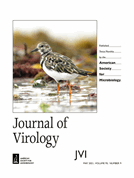Abstract Viruses from the Flaviviridae family, such as Dengue virus (DENV), Yellow fever virus (YFV), and Zika virus (ZIKV) are notorious global public health problems. ZIKV emergence in Polynesia and the Americas from 2013 to 2016 raised concerns as new distinguishing features set it apart from previous outbreaks, including its association with neurological complications and… Continue reading Development of a quantitative NS1 antigen enzyme-linked immunosorbent assay (ELISA) for Zika virus detection using a novel virus-specific mAb
Tag: Emerging Viruses
West Nile virus emergence and spread in Europe found to be positively associated with agricultural activities
The spread of West Nile virus in Europe is strongly linked to agricultural activities, urbanization, and bird migration, according to new research.
[Media Watch] Africa’s lessons of resiliency and preparedness after Ebola
Tolbert Nyenswah’s book Collapse and resiliency: the inside story of Liberia’s unprecedented Ebola response offers a profound and meticulously detailed exploration of Liberia’s reaction to 2014’s devastating Ebola epidemic. Nyenswah provides a first hand and compelling narrative of the challenges confronted by Liberia, Guinea, and Sierra Leone during this crisis, when he served as the… Continue reading [Media Watch] Africa’s lessons of resiliency and preparedness after Ebola
N6-methyladenosine modification positively regulate Japanese encephalitis virus replication
N6-methyladenosine (m6A) is present in diverse viral RNA and plays important regulatory roles in virus replication and host antiviral innate immunity. However, the role of m6A in regulating JEV replication has… Continue reading on BioMed Central
Publisher Correction: Rational design of a ‘two-in-one’ immunogen DAM drives potent immune response against mpox virus
Correction to: Nature Immunology https://doi.org/10.1038/s41590-023-01715-7, published online 5 January 2024. In the version of the article initially published, there were errors in the title, abstract, main text and editor’s summary where “mpox” mistakenly appeared as “monkeypox”. This has been corrected in the HTML and PDF versions of the article. Author informationAuthor notes These authors contributed… Continue reading Publisher Correction: Rational design of a ‘two-in-one’ immunogen DAM drives potent immune response against mpox virus
TWiV 1079: Rock of phages
TWiV reveals how viruses participate in the organomineralization of travertines, and how neutralizing antibodies evolve to exploit vulnerable sites in the hepatitis C virus envelope glycoprotein E2 and mediate clearance of infection. Hosts: Vincent Racaniello, Dickson Despommier, Alan Dove, Rich Condit, Kathy Spindler, and Brianne Barker Click arrow to playDownload TWiV 1079 (82 MB .mp3, 114… Continue reading TWiV 1079: Rock of phages
Prefusion stabilization of the Hendra and Langya virus F proteins
Mapping healthy cells’ connections in the brain
AI SummaryResearchers at MIT’s McGovern Institute have developed a new tool that allows neuroscientists to identify connected neurons in the brain and manipulate them over an extended period of time. The tool, which builds upon previous research, uses a modified rabies virus to trace neuronal connections and limit its spread, reducing toxicity. The system opens… Continue reading Mapping healthy cells’ connections in the brain
A conformational selection mechanism of flavivirus NS5 for species-specific STAT2 inhibition
Abstract Flaviviruses, including Zika virus (ZIKV) and Dengue virus (DENV), rely on their non-structural protein 5 (NS5) for both replication of viral genome and suppression of host IFN signaling. DENV and ZIKV NS5s were shown to facilitate proteosome-mediated protein degradation of human STAT2 (hSTAT2). However, how flavivirus NS5s have evolved for species-specific IFN-suppression remains unclear.… Continue reading A conformational selection mechanism of flavivirus NS5 for species-specific STAT2 inhibition
Protection against symptomatic dengue infection by neutralizing antibodies varies by infection history and infecting serotype
Abstract Dengue viruses (DENV1–4) are the most prevalent arboviruses in humans and a major public health concern. Understanding immune mechanisms that modulate DENV infection outcome is critical for vaccine development. Neutralizing antibodies (nAbs) are an essential component of the protective immune response, yet their measurement often relies on a single cellular substrate and partially mature… Continue reading Protection against symptomatic dengue infection by neutralizing antibodies varies by infection history and infecting serotype




